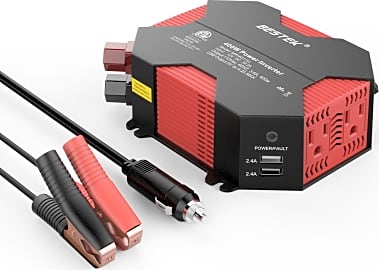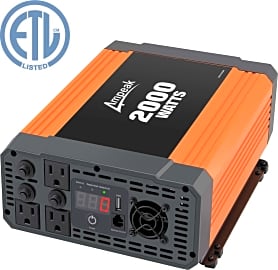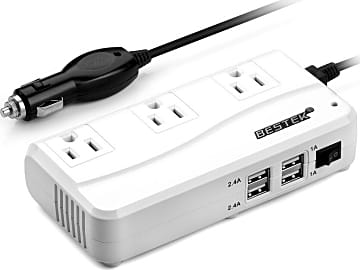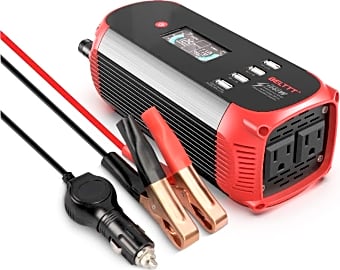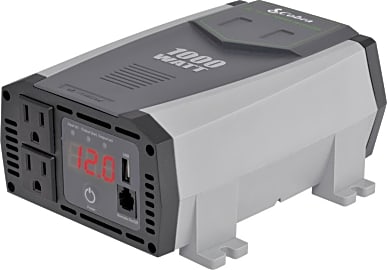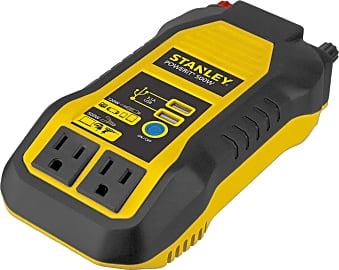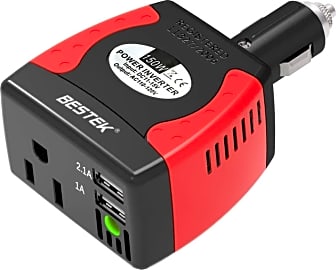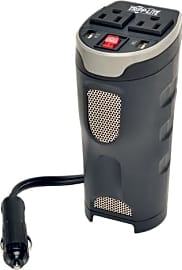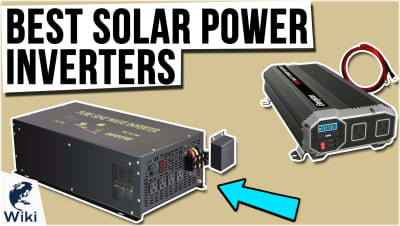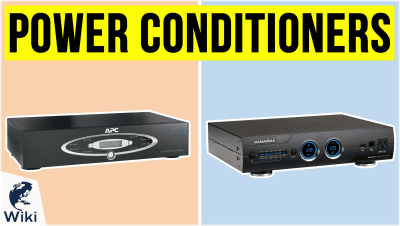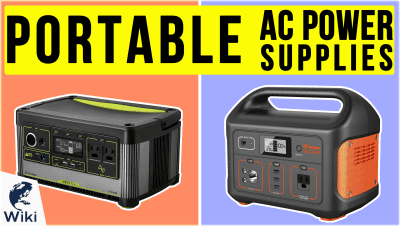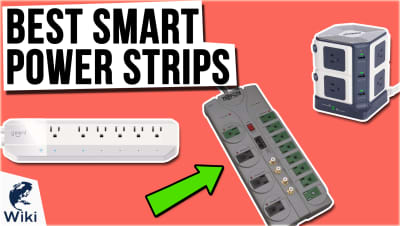The 10 Best Power Inverters

This wiki has been updated 43 times since it was first published in May of 2015. Turn your car's battery into a mobile generator with one of these power inverters. Smaller, budget-oriented models can run cell phones and other light equipment in your car's cabin, while larger ones may be able to run things like refrigerators, computers, and coffee makers. For safety's sake, follow all directions carefully, and hire a licensed electrician for installations that involve wiring. When users buy our independently chosen editorial selections, we may earn commissions to help fund the Wiki.
Editor's Notes
December 18, 2020:
A great solution for charging on the go, these power inverters come in a range of outputs for charging small and mid-sized devices. The compact Bestek 75W was upgraded to the Bestek 150W, which now features dual 2.4 amp USB ports, and has an auto-shutdown feature to protect against overheating.
The Stanley PCI140 was replaced with a more powerful option, the Stanley PI500S Powerit. This model provides 500 Watts of output and can charge four devices at once. It comes with two battery clamps which are needed to make use of its full output, otherwise, it is restricted to 140 watts through the cigarette lighter socket.
Finally, we included the innovative Belttt Intelligent and the Tripp Lite PV200CUSB. The former features a color display that provides useful information on battery status and output voltage, and the former has a cup-holder design that makes for convenient storage, and four output options for three-pin plugs and USB cables.
June 28, 2019:
In this update, the newly added Krieger KR1100 moves into the top spot as a reliable option that can handle a sizable load of electronics, including laptops, fans, vacuums, blenders, power tools, and more. It conveniently comes with the battery cables to make a quick and easy job of hooking it up. With the wired remote, you’ll be able to control it without having stand right next to it, which proves useful with larger vehicles like RVs and trucks. It features a clear LCD screen that lists its input voltage and output wattage, as well as if any protections are in play for problems with overload, high temperature, or short circuits. It’s from an American company headquartered in Florida that was founded less than a decade ago, but which has developed a reputation for producing quality modified sine wave inverters. They’re contracted by the U.S. government and other governments around the world.
Also joining the selection is the Ampeak 2000W, which can be trusted to keep your devices running smoothly during electrical outages. It can even power a small refrigerator. Like many others, it’s built to safeguard against overloads and other harmful situations. It comes with handy mounting holes for those who wish to create a more permanent installation.
Leaving the list are the Power Bright PW1100-12 and the Safergo Ultra-Slim, due to some quality-related reports.
On a safety-related note, today’s power inverters are made with plenty of protective features like cooling fans, overload indicators, low-battery alarms, and automatic shutdown. That being said, never use an inverter without first reading its user manual and following all directions carefully. If a vehicle is powering your inverter, be sure that it is outside and not in a closed-up garage, and keep the inverter away from anything that releases flammable gas. Once the inverter is hooked up to your car, keep it as far away from the engine compartment as possible. If you’re looking to do any type of installation that requires wiring (some inverters can be grid-tied), be sure to hire a licensed, knowledgeable electrician.
Coining The Term Inverter
They consisted of a DC generator, or dynamo, and a set of slip rings evenly spaced around the rotor's windings.
The first power inverters were used to create DC power from AC power for industrial, commercial, and railway electrification. At the time, they weren't called inverters, but were known as rotary convertors. They created power in much the same way as today's generators create power, except with a system designed for producing DC current instead of AC current. They consisted of a DC generator, or dynamo, and a set of slip rings evenly spaced around the rotor's windings.
When spun, the dynamo would create an alternating current that would be rectified by a commuter, allowing DC current to be extracted. In essence, the DC power is separately generated from the AC power by using a synchronous converter.
If controlled correctly, a DC convertor can also be set to run backwards, using the DC power to create AC power. The name inverter was coined because at the time, it was just a DC rotary converter running backwards, or an inverted converter. It is believed that David Prince coined the term inverter.
In 1925, he published a paper in the GE Review entitled "The Inverter", which contained almost all of the vital elements in modern day inverters. It was also the first known publication to use the term inverter in literature. By 1936, Prince's inverter became common terminology in technical publications around the world.
How Power Inverters Work
Power inverters are needed to convert direct current, like the kind that comes from a car into an alternating current that can be used by standard electronics. Early AC power inverters were electro-mechanical. DC power flowed from one end of a circuit that had an electromagnet attached to it. Once the current contacted the magnet, it would activate and pull a wire that was attached to a spring arm. This would force the wire to come in contact with the circuit, changing the flow of the current from one side to other other side of the circuit. At the same time, this would cut the power from the electromagnet.
At the same time, this would cut the power from the electromagnet.
Once the magnet was released, its spring arm would snap back, allowing the current to begin flowing from the original side of the circuit once again. This would activate the magnet again and the process would repeat itself.
Modern day inverters are doing essentially the same thing, but instead of using electromagnets and spring arms, they make use of semiconductors as switches. This eliminates the need for an arm to flip back and forth in order to alternate the current.
All alternating currents produce a sine wave of some form. AC in the home is a smooth, rounded sine wave, but many types of inverters create a squarish sine wave. This is fine for basic electronics, like coffee makers or blenders, but if running sensitive electronics that send and receive broadcasts of some kind, square sine waves can be problematic. For this reason, many modern inverters had a number of filters, capacitors, and inductors which are used to clean up the sine wave so it can be used by nearly any type of electronic device.
How To Select An Inverter
When selecting an inverter, the first step is matching the inverter to the voltage of the power source. If you will be using an inverter in with a car battery, you would need a 12-volt inverter as it will be drawing power from a car's 12-volt battery.
After identifying the correct voltage for your inverter, it is time to determine your power needs. To do this, you must have some idea of the electronics you want to power with the inverter. Look for a label on your devices that tells the required wattage. Your inverter must be able to produce at least this amount of wattage, preferably higher.
After identifying the correct voltage for your inverter, it is time to determine your power needs.
If you plan on powering multiple devices at the same time from your inverter, you need to add up the required wattage of all the devices. For example, if you have a coffeemaker that uses 600 watts, and you also plan on running a toaster oven at the same time which requires 1000 watts, you would need an inverter rated for a minimum of 1600 watts.
One must also take peak power into account. Some electronics use more power when starting up. This is known as the peak power rating. For example, a blender may be rated as using 600 watts, but have a peak or surge power rating of 800 watts. This means that it uses 800 watts at startup and then drops down to 600 while it is in operation. Most inverters also have a peak power rating that is higher than their operating wattage as they are designed to deal with this kind of load, but one should check the peak power rating of both devices first to ensure they are compatible.
Finally, one should look at the wave output. As we mentioned previously, inverters generally put out a square sine wave unless they have a number of filters and inductors incorporated to smooth out the wave. If you plan on using basic, non-audio and visual electronics, the wave output won't be as important, but if you want to be able to power a laptop or charge a smartphone, then an inverter with a "perfect sine" wave should be considered. These can be quite expensive though, so another option is an inverter with a modified sine wave. These will have enough filtering that they can generally be used with most electronics, but not perfectly rounded wave.


